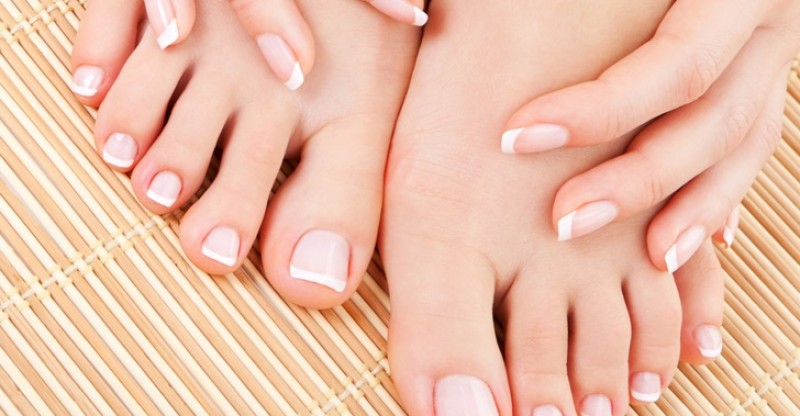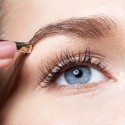How to Avoid Toenail Fungus – Prevention and Treatments
When you glance at your feet, you should expect to see healthy, clear nails.
But this is not always the case.
Some people may think that the occasional yellow or discolored nail is not something to worry about.
However, 50% of nail discoloration is caused by fungus.
It takes a few months to years to eliminate this infection, especially if you are taking certain medications or you have a compromised immune system.
Preventing the occurrence of nail fungus may not be included in your top to-do list, but maybe it should be.
Fungi are almost everywhere and they love warm, moist and dark places, including the insides of your shoes.
That makes it quite easy to develop a toenail fungus.
Nail fungal infection can be an embarrassing problem as it can make you feel conscious whenever you are barefoot.
How Toenail Fungal Infection Develops
Onychomycosis or nail fungus is a very common condition.
It is estimated that 3 to 12 percent of the population are suffering from nail infection caused by fungi.
Older people have a higher risk of getting toenail fungus than younger people due to circulation problems.
This infection does not usually have any serious complications in healthy people, but if left untreated, it can easily spread out (1).
These microscopic fungi can easily find their way into your toenails under numerous circumstances.
Toenail fungus commonly occurs when dermatophytes, a type of fungus, inhabits the nail.
The infection can also be caused by a yeast infection or a general mold in the area.
Whether yeast, mold or fungus, all these nail infections are developed in moist, warm and dark environments (2).
Other risk factors include diabetes and health conditions that contribute to poor blood flow.
Patients who are immunosuppressed, such as those undergoing cancer therapies and with HIV infection, have a higher risk of getting toenail fungus (3).
Signs and Symptoms of Toenail Fungal Infection
Toenail fungus usually starts as white patches on the surface of the nail, either in small dots or large blotches.
As the infection goes deeper, it can cause your nail to crumble, thicken and become discolored.
Other symptoms include debris trapped under the nail, lifting up of the nail, brittleness, change in shape and loss of shine (4).
It may also start producing a foul odor and wearing shoes can be painful as thickened nail adds pressure on the nail bed.
This may also lead to difficulty walking.
This nail condition also increases the risk of bacterial infection of the surrounding skin in people with the weak immune system or those with diabetes.
Toes usually have less blood circulation, making it more difficult for the immune system to detect and inhibit the infection.
Fungal signs can show up gradually but may last for years. Getting rid of it will require time and patience.
Fortunately, there are ways to avoid toenail fungus.
How to Avoid Toenail Fungus
Fungi do not need sunlight to survive.
They live in moist, warm environments, including showers, swimming pools, hot-tubs, steam-rooms, locker-rooms, and gyms.
Just walking barefoot in these places can increase your risk of getting a fungal infection.
The warmth of your socks and shoes, especially if you are always sweating, is another ideal breeding ground for fungal infections.
As the famous saying goes, prevention is always better than cure.
Follow these useful tips on how to avoid toenail fungus.
Wash Your Feet Regularly
Always wash your feet with warm water and antibacterial soap to keep them clean.
Doing this daily will significantly reduce the risk of developing a fungal infection.
Make sure that you also wash between your toes and nails thoroughly.
After washing your feet, dry them completely.
Get in-between toes as well to keep fungus away from your toenails.
Wear Sweat-Absorbing Socks
Fungus and molds thrive in wet, dark places, so always dry your feet after taking a bath or shower.
Because the chances of getting a fungal infection are related to the level of moisture, using socks that absorb sweat is one of the best ways to avoid toenail fungus.
Avoid cotton socks and look for items that are made of wool, polypropylene or nylon.
Change your socks regularly, especially if you sweat a lot.
Avoid Walking Barefoot in Public Areas
Fungus loves to thrive in wet, warm places. It can also spread from one person to another.
Walking barefoot in public areas like a locker room, swimming pools and shower rooms can increase your probability of getting an infection.
Always wear sandals while walking in these places to diminish your chance of developing toenail fungus.
Even when taking a shower in public facilities, it is important to wear flip flops or shower shoes as the fungus that causes ringworm, athlete’s foot and other skin conditions may be present on the floor.
Choose Breathable Footwear
To effectively avoid toenail fungus, it is important to consider your choice of footwear.
Wearing confining shoes throughout the day, particularly damp shoes, can increase your chances of developing a fungal infection.
If possible, consider wearing open-toed footwear during the day.
Replace your old shoes with new ones or use anti-fungal powder to get rid of harmful microorganisms that may be present in your shoes.
This is important especially during a hot season when your feet produce more sweat.
Trim Your Toenails Short
Keeping your nails trimmed short helps in preventing debris and dirt from building up under your nails.
This also lessens the surface area upon which microorganisms may grow and reduces the risk of nail injuries.
Simply cut your toenails straight across to keep them strong and prevent ingrown.
Make sure that you use properly sanitized clippers and nail file.
Do not share nail clippers and files with someone else.
Alternate Your Shoes
Invest in a few good pairs of properly fitted shoes and use them alternately.
Avoid putting on shoes that are still a bit wet from yesterday’s workout.
After every use, leave them in an open space where they can dry thoroughly.
It is also best to wear separate shoes for work and for exercise.
Your running shoes hold a lot of moisture and sweat and wearing them again for normal activities may allow the fungal infection to develop.
Protect Toenails from Injuries and Trauma
One of the best reasons why you need to be extra careful not to bump into things is that even a small cut can give fungus an opening to penetrate into your nail bed.
Wearing ill-fitting shoes can also confine your toe area and may add more pressure to your toenails.
Make sure that you wear shoes that provide enough room for your toes.
When it comes to scrubbing your feet, avoid rough bristles as they can easily damage your toenail beds.
Keep Toenails Natural
Nail polish may seem appealing and attractive.
However, they trap additional moisture in your toenails and enhance the risk of toenail fungus.
If possible, avoid applying nail polish.
When attending a nail salon, ensure that you visit a reliable one that maintains their equipment and tools clean.
Look around to check if the staff is disinfecting footbaths and sanitizing tools thoroughly before each use.
If you still want to go for a manicure and pedicure, it is alright to do so.
The trimming and cleaning of your toenails can be beneficial to reduce the risk of infection.
However, it is best to skip the nail polish to prevent additional entrapment of moisture in your toenails.
Do Not Snip Cuticle Away
Your cuticle is the last line of defense against bacteria and fungus penetrating through your toenail bed.
Snipping it away makes you susceptible to fungal and bacterial infections.
It will also come back thicker and heavier each time you snip it away.
Treatments Available if You Develop an Infection
If it is too late to avoid toenail fungus, there are many medications that you can try to clear the infection.
If caught early, it may disappear with over-the-counter antifungal cream, gel, lacquer or lotion.
You can also try home remedies if you see some spots forming.
Tea Tree Oil
Tea tree oil contains anti-fungal and antiseptic properties, making it effective in treating toenail fungus.
This oil is also useful for treating other skin infections, including eczema, athlete’s foot, ringworm, and scabies.
To use tea tree oil, mix a few drops of it with coconut oil or olive oil.
Apply the mixture on the infected nail using a cotton ball.
Let it sit for about ten minutes and scrub the nail gently with a soft tooth brush.
Repeat this treatment three times daily (5).
Apple Cider Vinegar
Apple cider vinegar contains acidic properties that can help in killing fungi and bacteria present in your toenails.
Mix equal parts of water and apple cider vinegar in a foot basin and soak your toenail in the solution.
Leave it on for thirty minutes before rinsing it off with water. Dry your feet thoroughly.
Alternatively, you can mix a few spoons of apple cider vinegar with ground rice flour to make a paste.
Apply this to the infected nail and scrub the area with a toothbrush.
Follow this natural treatment a few times a week.
Listerine Mouthwash
Listerine mouthwash kills germs and bacteria in the mouth, making it useful in eliminating the fungal infection.
It contains several compounds that can keep fungi and other harmful microorganisms at bay.
Soak your affected toenail in a small basin filled with Listerine mouthwash.
You can also add white vinegar for additional benefits.
Leave it for thirty minutes and scrub the nail gently.
Rinse it off and dry thoroughly. Follow this treatment twice daily to clear the infection.
Lavender Oil
Lavender oil can also be used to treat fungal infections.
It shows a powerful anti-fungal effect against the skin and nails fungal infections (6).
To use, mix a few drops of lavender oil with tea tree oil.
Apply this solution to the infected areas using a cotton ball.
Let it sit for at least ten minutes before rinsing it off with water. Repeat this remedy thrice daily.
Garlic Oil
Garlic contains powerful anti-fungal properties that can help in treating nail fungal infections.
Simply mix equal parts of garlic oil and white vinegar.
Apply the mixture on the infected area and cover it with a bandage. Let it sit for a few hours.
If garlic oil is not available, you can fry some crushed garlic cloves in olive oil.
Strain and let it cool down. Use this oil to treat the infection.
Baking Soda
Another effective remedy for toenail fungus is baking soda.
It also helps in neutralizing foot odor caused by fungal infections.
To use this, mix 1/2 cup of baking soda with 1/4 cup of 3% hydrogen peroxide, 1/4 cup of white vinegar, 1/2 cup of Epsom salt and 4 cups of hot water.
Soak your feet in this solution for ten minutes. Rinse the area and dry thoroughly.
Follow this treatment twice daily until the infection is gone.
Oregano Oil
When it comes to home remedies for toenail fungus, oregano oil always makes it to the list.
It contains anti-fungal, antibacterial, antiseptic and analgesic properties, making it an effective treatment for nail fungal infections.
Mix two drops of oregano oil with one teaspoon of olive oil.
Use a cotton ball to apply the mixture on the affected toenail.
Let it sit for at least thirty minutes before rinsing it off with water.
Dry your feet thoroughly. Follow this treatment twice daily for best results.
Lemon Juice
Lemons contain both anti-fungal and antiseptic properties.
Its citric acid also helps inhibit the infection from spreading.
Simply apply fresh lemon juice on the affected toenail and leave it on for thirty minutes.
Rinse it off with warm water.
Alternatively, you can combine lemon juice with an equal amount of olive oil.
Apply this mixture to the affected area and leave it on for a few hours.
Wash it off with water and dry.
Conclusion
Toenail fungus is very common and it causes the infected nails to become thick, brittle and discolored.
In severe cases, the nail may fall off from the nail bed.
Knowing how to prevent this infection from occurring can save you a lot of time and effort from medications and treatments.
To lower your risk of getting an infection, follow the simple methods above on how to avoid toenail fungus.
FDA Compliance
The information on this website has not been evaluated by the Food & Drug Administration or any other medical body. We do not aim to diagnose, treat, cure or prevent any illness or disease. Information is shared for educational purposes only. You must consult your doctor before acting on any content on this website, especially if you are pregnant, nursing, taking medication, or have a medical condition.
HOW WOULD YOU RATE THIS ARTICLE?






